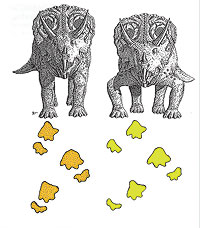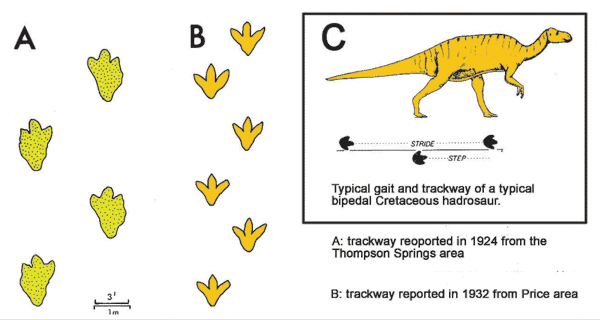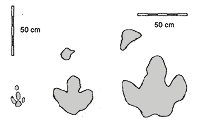 |
| Fig. 1. The posture of larged horned dinosaurs (Ceratopsians) has been much debated. Leg bone articulations suggest a sprawling gait (right) but trackways (left) suggest more erect posture. |
In last month’s Moab Happenings we looked at the large tracks known from the Book Cliffs area between Western Colorado and Price, Utah. Large tracks mean large trackmakers that seem to evolve with time in most major groups: theropods, hadrosaurs and ceratopsians. We can look again at these tracks from a historical viewpoint as they generated much enthusiasm when first discovered. We can also follow debates about posture and gait.
We have seen that the changes in the position of the Cretaceous shoreline varied through time. As sea level rose globally, 100-million years ago, the shoreline in the area that now represents Utah moved west, then by 20 million years later it migrated back eastward ~80 million years ago. This was more than enough time for some of the major dinosaurian groups to evolve and migrate across the region leaving many tracks. The variation in the skulls of horned dinosaurs (ceratopsians) and duckbilled hadrosaurs is particularly striking and can be compared from north to south as well as from east to west. The same cannot be said for the tracks of these animals which are all very similar in appearance and hard to differentiate. So, skulls vary in shape, but feet apparently do not. Almost all ceratopsian tracks are represented by isolated casts. There is in fact only one example of a ceratopsian trackway (named Ceratopsipes) indicating that the hind foot was four-toed, while the front of manus track was five-toed (Fig. 1). These animals were all quadrupeds. By contrast the tracks of hadrosaurs all indicate a three-toed pes, a very small-rounded, hoof shaped manus and a bipedal gait. In this group the manus only registered tracks in some trackways. Both hadrosaur and ceratopsian tracks are found in Colorado and Utah as well as in Wyoming and other states.
 |
| Fig. 2. Two trackways from the Book Cliffs area were reported and between 1926 and 1932. They indicate a bipedal gait and large animals with footprints up to 1.00 meter + and strides of ~5.00 m |
When one has only a small sample of material to study it allows some latitude in debate. For example a large surface area is needed to show the configuration of a trackway. The posture of ceratopsians was long debated: did they sprawl or walk upright? The lack of many well-preserved leg bones and trackways made this a problem for interpretation. The answer based on trackways is that they were neither exaggerated sprawlers or fully erect. This is an area where tracks are particularly helpful.
 |
| Fig. 3. Ornithopod tracks come in a large range of sizes from ~10 cm - ~80+ cm. Note the small manus track which indicates a quadrupedal gait for small and large trackmakers. Compare with Fig 2 showing bipedal gaits |
The Price area coal mines are also important having yielded track finds back to the 1920s. The most famous excavation was done in a mine near Cedaredge, Colorado, but the Price area heads the list of extracted footprints. These tracks were named as Dinosauropodes. The largest of these can be 80-100cm in length and width for the hind footprints. These trackmakers had variable gaits suggesting that they could switch between bipedal and quadrupedal progression. Some hadrosaur dinosaur specialists regard smaller, sub-adult as likely to have been bipedal whereas the larger individuals were quadrupedal. This hypothesis has not been supported by local recent finds which include trackways of small quadrupedal trackmakers.
|